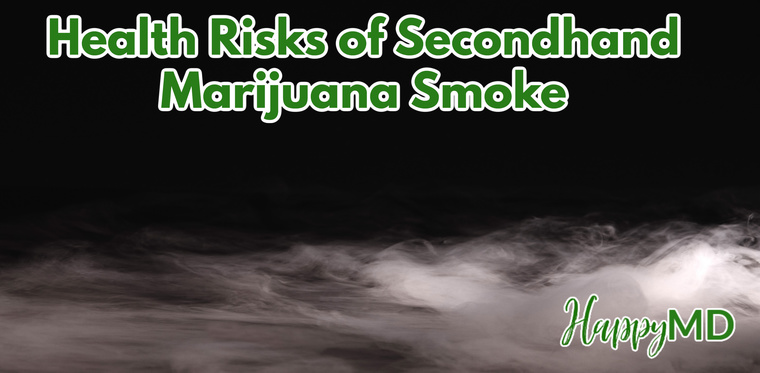
Check Out the Health Risks of Secondhand Marijuana Smoke
Health Risks of Secondhand Marijuana Smoke: Secondhand smoke is the smoke one inhales when a person nearby lights up a weed blunt. Recently, there has been an increased popularity of cannabis mainly due to its legalization in most states across the U.S. Most people are now using marijuana products because of their health benefits, including relief of chronic pain, improved lung capacity, preventing diabetes, regulating seizures, alleviating anxiety, and treating depression.
In addition, there are many products to choose from, including vape juice, edibles, drinks, and marijuana creams. However, there are many health risks associated with smoking cannabis. Although smoking cannabis isn't as dangerous as smoking tobacco, we can't neglect that marijuana can cause severe negative effects on one's health.
Even worse, the cannabis smoke doesn't affect the smoker only but even the people nearby. This article is dedicated to helping you learn and understand the possible health effects of secondhand marijuana smoke.
A Highlight of the Possible Health Effects of Secondhand Cannabis Smoke
The possible health effects of cannabis smoke include:
- Marijuana smoke contains chemicals and metals, including ammonia, chromium, lead, mercury, nickel, cadmium, and hydrogen cyanide. Most of these contaminants are carcinogenic.
- Cannabis smoke contains particulate matter, and when these fine particles are inhaled into the lungs, they cause respiratory problems, including COPD, lung irritation, and asthma attacks.
- Secondhand marijuana smoke can cause cardiovascular problems. The health effects of cannabis include atherosclerosis, decreased blood pressure, and dilation of blood vessels.
- Vaporizing fumes also cause problems to the people nearby. These effects are similar to those of air pollution caused by wildlife fires.
- People suffering from secondhand exposure to cannabis smoke may have impaired blood vessel function.
The effects of secondhand marijuana smoke are even more adverse if the cannabis is contaminated with mold or insecticides. Exposure to this kind of secondhand cannabis smoke can cause damage to the lungs.
Health Risks Associated with Secondhand Cannabis Smoke
There are many health effects associated with secondhand cannabis smoke, just like it's the case with tobacco. Cannabis smoke mainly affects the respiratory system. As the smoke and other particles are inhaled, the throat, airways, and lungs are affected. Inflammation of these organs increases the risk of developing respiratory diseases such as bronchitis and chronic cough.
Cannabis smokers inhale this smoke differently from how tobacco smokers do it, which can lead to more health issues. For instance, cannabis smokers inhale the smoke more deeply and hold the smoke for a more extended period.
The level of impairments, whether high or low for secondhand cannabis smokers, mainly depends on the room's ventilation and proximity. Research on tetrahydrocannabinol (THC) on individuals who were exposed to secondhand cannabis showed the following results:
- High levels: The drug test showed positive results for individuals exposed to an hour of secondhand marijuana smoke in an unventilated room, and the individuals had impaired memory and motor skills.
- Low levels: The results were collected from individuals exposed to secondhand marijuana smoke for three hours. The drug test showed negative results.
The other uncomfortable side effects of inhaling secondhand marijuana smoke include headache, nausea, restlessness, fatigue, anxiety, itching eyes, and dry mouth.
In most cases, the negative health impacts of smoking marijuana outweigh the benefits. However, this is a personal decision, and each individual can make an independent conclusion without judgment. However, it's essential to consider the health effects of the people near you, including your colleagues, family, and friends.
Smoke is formed when any material containing carbon is burnt under high-temperature conditions. All the products contained in the materials are usually broken down and escape to the air in gaseous form or very fine particulate matter. Other than THC, the marijuana compound that causes a high sensation, the cannabis smoke contains other toxins and chemicals. The most common metals, chemicals, and toxins present in the cannabis smoke are:
- Isoprene
- Benzene
- Acetaldehyde
- Formaldehyde
- Hydrogen Cyanide
- Nickel
- Arsenic
- Mercury
- Ammonia
- Lead
- Quinoline
- Chromium
- Cadmium
Ammonia is the most abundant product of the combustion of cannabis which is very far from the amount produced by the cigarette. It's important to note that high ammonia concentrations in cannabis smoke can irritate the nose, throat, and respiratory tract. This also affects secondhand smokers, and thus you should be very careful when sitting close to someone smoking marijuana.
A Comparison of Secondhand Cannabis Smoke and Tobacco
Cannabis and tobacco produce about 4000 chemicals that are closely related when smoked, although these two products have very different active ingredients. Both marijuana and tobacco have profound effects on the mind and body. However, the effects of smoking a drug on the lungs can be very similar regardless of the drug type.
Inhaling cigarettes smoke not only deliver psychoactive substance to the body but also deliver carcinogens and toxins to the lungs. According to the American Lung Association reports, smoking cannabis is just as harmful as smoking cigarettes.
The mode of inhalation of cannabis is very different compared to that of nicotine cigarettes. When smoking cannabis, there is increased exposure to tar since cannabis smokers inhale the smoke more deeply and hold their breath for a more extended period. This makes the health effects of smoking cannabis even more adverse compared to smoking nicotine.
In addition, cannabis smoke may potentially have more carcinogens and toxins than cigarette smoke. This is because this product is still illegal in some parts of the world and isn't subject to strict standardizations. The vendors may also add other substances without your knowledge resulting in more damage to the respiratory organs based on smoke alone.
According to a study conducted by researchers on rats showed that cannabis had more adverse effects than cigarettes. The study showed that the rats' blood vessels dilated within 1 minute of cannabis exposure. These effects were seen on rats exposed to THC-free cannabis and cannabis containing 4.5% THC.
The rats exposed to cigarettes and marijuana had impaired flow-mediated dilation (FMD). However, the effects lasted longer in cannabis, 90 minutes and only 30 minutes for cigarette exposure.
All in all, more studies need to be conducted to establish if these results are translatable to humans. But, it's important to note that secondhand marijuana smoke is potentially more dangerous than secondhand nicotine smoke.
What Are the Risks of Secondhand Smoke for Children?
Secondhand cannabis smoke should be a great concern among parents who still live with their children. The health effects are more severe among children than adults since their organs are still developing and their immunity is low. Inhaling secondhand smoke puts children at risk of contracting respiratory illnesses, asthma, and ear infections. On top of this, secondhand cannabis smoke puts children at risk of sudden infant death syndrome (SIDS).
Even with the decrease in the number of parents smoking tobacco, the number of parents using cannabis is still on the rise. A survey conducted between 2002 and 2015 indicated that the number of tobacco users decreased from 27.6% to 20.2%. However, among the parents who smoked tobacco, cannabis users increased from 11% to 17.4% and from 2.4 to 4.0 in those who didn't smoke tobacco.
Another study was conducted to test THC presence in children exposed to secondhand cannabis smoke in the urine. This study showed that almost half of the children exposed to secondhand cannabis smoke showed detectable levels of marijuana in their urine.
A study conducted on children hospitalized with bronchitis found that for those whose parents smoked weed, the urine results tested positive for THC-COOH. THC-COOH is a product of THC metabolism, and it stays in the body for a longer period than THC itself.
The exposure of THC to children is worrying due to its known negative effects on the development of the brain in young people. Secondhand marijuana smoke causes other long-term developmental damage in growing children.
Thus, it's important for parents who smoke tobacco or marijuana to exercise the following precautions:
- Avoid smoking in areas where the children might play or sit, including your car and home.
- Always wash your hands and face well after smoking and change your clothes before having any contact with the children.
- Put on a headscarf or a hat any time you're smoking to protect your hair and prevent smoke from sticking into the hair.
- Avoid smoking in places where your children are to protect them from secondhand cannabis smoke and its severe effects on their health.
- Select another option of using cannabis products, including topicals, CBD products, or edibles.
Is It Possible to Get High from Secondhand Cannabis Smoke?
It's a great concern among most people if contact high is really a thing. The drug tests differ when people exposed to secondhand cannabis smoke are tested, and thus the clinical data available is very limited. Several kinds of research have shown that it's possible to get high when one is exposed to secondhand cannabis smoke.
Researchers at John Hopkins University conducted a study by using six non-smokers and six smokers put together in a sealed room. Each smoker was given ten weed blunts, and they were told to smoke them at their will for a period of one hour. At the end of the exposure to cannabis smoke, the effects of non-smokers were measured for 34 hours after the whole session was concluded.
The total number of sessions conducted was three. During the first and the second session, marijuana with 5.3% and 11.3% were used, respectively. In both sessions, the rooms were unventilated.
After the first session, there was an increase in the THC-COOH levels in the urine samples of the non-smokers, even though it wasn't very significant. But, after the second session, the level of THC-COOH in the urine samples of non-smokers increased significantly to detectable levels of 15ng/ml in more than 10% of the samples.
After the experiment, there was an impaired cognitive function, moderate sedation, and a slight increase in heart rates effects observed among the non-smokers. A case of feeling sick, a case of a racing heart, and another case of anxiety were reported.
In the third session, cannabis containing 11.3% of THC was used, but this time, the room was ventilated at a close level to that of the home air conditioning system. There were no intoxicating effects experienced from this session among the non-smokers, and the THC-COOH levels in the urine dropped to insignificant and undetectable levels.
We can conclude from this study that even though secondhand cannabis smoke can cause a high sensation, the risks are greatly minimized when this is done in a well-ventilated space.
Although getting high from secondhand cannabis in a well-ventilated room is uncommon, the cannabis side effects are worse. Some of the cannabis side effects include:
- Depression
- Coughing
- Headaches
- Dry mouth
- Lethargy
- Dizziness
- Nausea
- Headaches
- Delayed reflexes
What are the Effects of Secondhand Smoke from Vaping Marijuana?
There has been an increased popularity in vaping over recent years. This is mainly because of the belief that vaping is healthier than smoking cannabis in the traditional way. Elevated temperatures cause the vape liquid to vaporize, thus releasing important compounds such as terpenes and cannabinoids. Thus, according to theory, vaping doesn't follow the combustion process, and hence fewer harmful chemicals are produced. However, in the actual sense, vaping isn't in any way a safer method of using marijuana.
According to a review done in 2018 by Americans For Nonsmoker's Rights (ANR), vaping isn't that good. This review showed that dabbing and vaping as methods of using cannabis is safer for secondhand smoke. However, these modern techniques also produce particles that can affect human health.
There has been a discovery that most people who get sick or die from vaping are usually affected by the black market. When vaporized, these products contain harmful ingredients, including vitamin E acetate and PRG 400, formaldehyde when heated.
Final Thought on Secondhand Marijuana Smoke
Even though most users believe that smoking marijuana is healthier than tobacco, this isn't the case. We can't refute that marijuana has many health and recreational benefits, but you should be cautious because of its many risks.
The decision to continue smoking cannabis or stop is yours to make. However, you should be concerned about its health effects on you and the people around you. It's advisable to protect others from secondhand cannabis smoke by smoking in well-ventilated spaces or using other cannabis consumption options. This is the info on Health Risks of Secondhand Marijuana Smoke



.png)